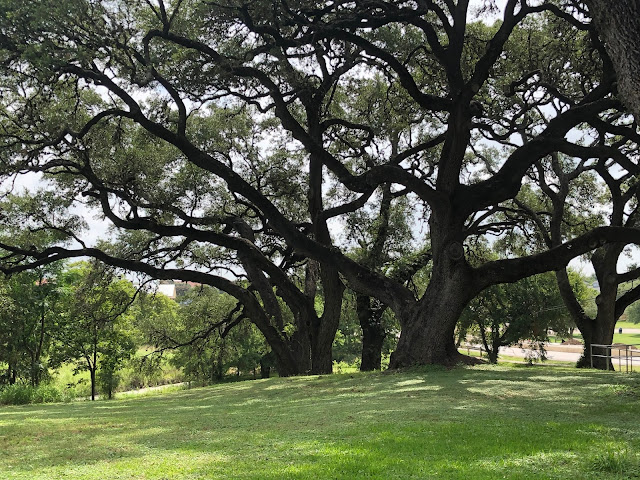The post office was finished in 1876 and served residents of the community and stagecoach passengers until 1880 when the Postmaster moved the post office to the nearby developing town of Du Pre, renamed Buda (pronounced BYOO-dah). in the late 1880's. The completion of the International & Great Northern Railroad lines to San Antonio and Laredo ended the necessity of a stagecoach stop.
 |
| These very large oak trees to the side of the house probably saw the stagecoaches arrivals and departures. |
T.E. McElroy and his wife bought the house and surrounding 234 acres and developed a successful livestock and agricultural program while eventually adding over 1,000 acres to the ranch. In 1906 Ann and John Severn purchased the ranch from the McElroy estate and continued the ranching operations. Upon their deaths the house and property saw several owners and the eventual sale of individual tracts of land. In 1998 the current owners, brothers Victor and Joe Stanzel, donated the house, post office building, and remaining 51-acres to the City of Buda with the stipulation that the house be restored and used for community purposes.
Renovation on the house revealed answers to questions about its transformation from the 1875 two room dog-trot style cabin to its current appearance. Updates are traced to 1885, 1900, 1920, and 1950. The Severns were very influential citizens and are thought to be responsible for the 1920 renovation; the house has been restored to that time period with the exception of a mantle painted by artists that rented the house for a time in the 1970's.
Evidence found during the renovation process indicates that the house was originally oriented to face the tributary of the creek located to what is now the rear of the house. The two rooms on either side of the front door comprised the original two room dog-trot cabin.
Each renovation seemed to change the structure even more while making it useful and modern for the residents. As a result, it assumed some strange characteristics that added interest to the house.
I stumbled upon this property on a recent visit to Buda and had no idea of its historical significance until I returned home and began researching it. I did not make many pictures, so a return trip when the weather cools off is on my go-to list. The surrounding park features many amenities as well as walking trails through the former stagecoach stop and ranching property.
The house serves at the Buda Visitor Center, but is currently closed due to the COVID pandemic. However, from reading the nomination form for the National Register of Historic Places designation about the evolution of the cabin to modern home I am sure it will be worth exploring.
 |
| The remains of a watering trough are located a short distance from the house. |




No comments:
Post a Comment